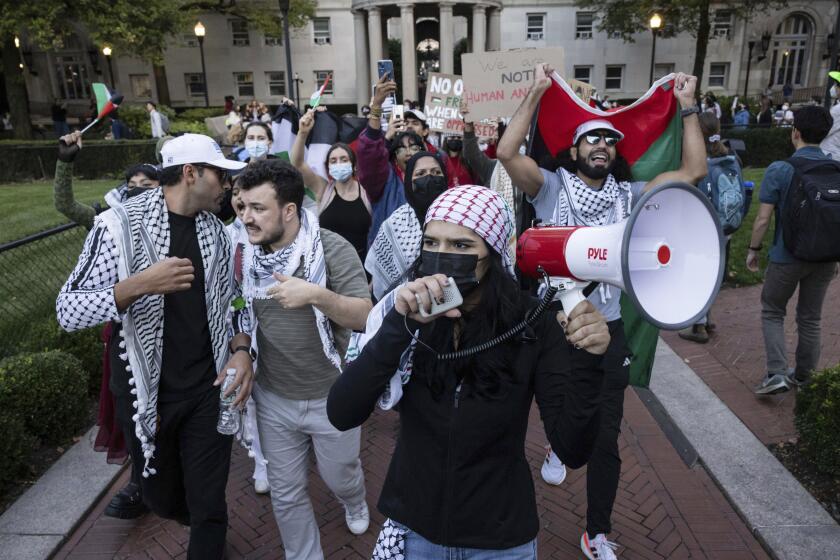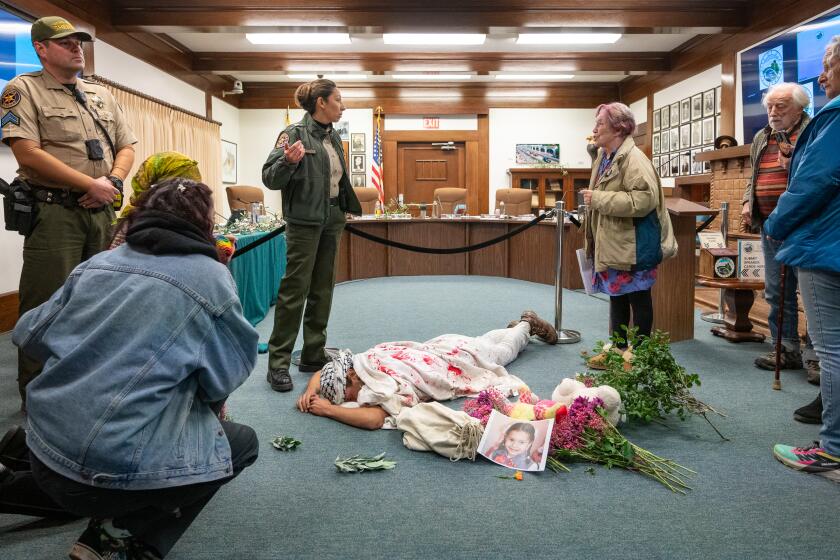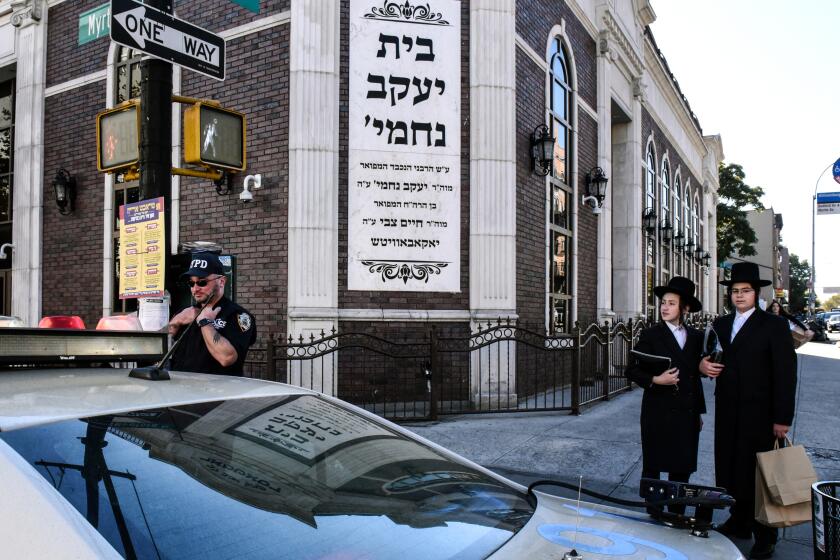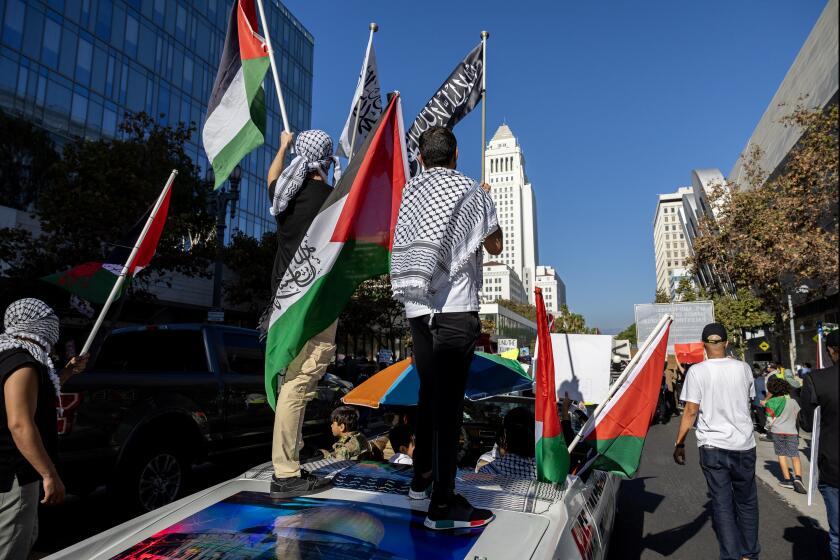The antisemitic cartoon roiling Harvard? It’s not the first time it caused a firestorm
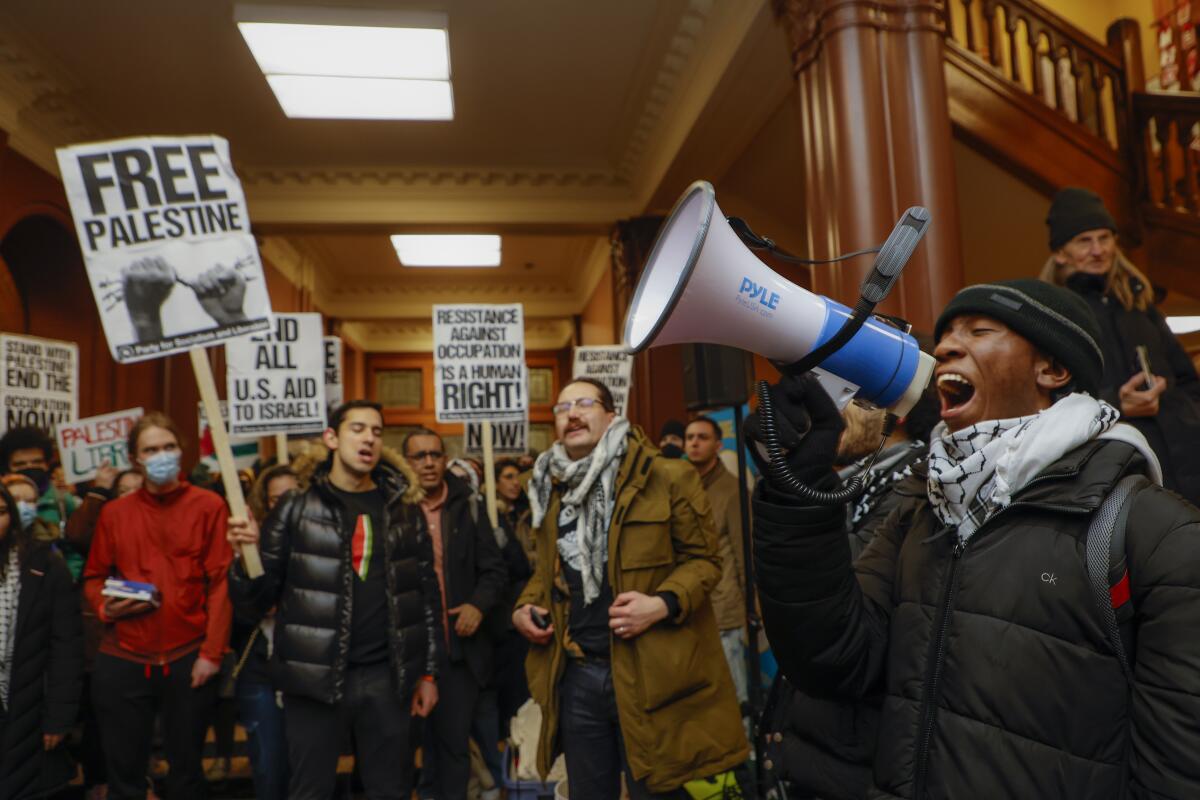
- Share via
When the Harvard Palestine Solidarity Committee and the Harvard African and African American Resistance Organization put together an infographic for Instagram, their goal was to showcase the historic connections between the Black and Palestinian liberation movements.
They gathered old images of Black activists who had been vocal advocates of the Palestinian cause, including Angela Davis and Malcolm X.
They quoted Nelson Mandela: “Freedom is incomplete without the freedom of the Palestinians.”
And they plucked an old cartoon from the archives of the Student Nonviolent Coordinating Committee — one that roiled the civil rights movement when it first appeared in 1967 and has lost none of its ability to outrage. The drawing shows a white hand, marked with a dollar sign inside a Star of David, tightening nooses around the necks of a Black man and an Arab man.
Drawn by Black artist Herman “Kofi” Bailey, it first appeared in a SNCC newsletter alongside an article fiercely critical of Zionism, leading to charges of antisemitism and furious condemnation of the SNCC from Jewish community leaders.
The Palestinian cause — and hostility toward Israel — has shifted from the sidelines of student activism to a robust political movement at U.S. colleges.
More than half a century later, the cartoon ignited another firestorm when it was posted on Instagram — and reposted by Harvard Faculty and Staff for Justice in Palestine.
“With Professors like these, it’s easy to see why we Jewish students don’t feel safe in class,” wrote Shabbos “Alexander” Kestenbaum, a Jewish student at Harvard Divinity School who sued the university last month, alleging it had failed to combat “severe and pervasive” antisemitism on campus.
“This should be called what it is,” Harvard Chabad posted on X, formerly Twitter. “Reprehensible. Bigoted. Hateful.”
The pro-Palestinian activists deleted the original post Monday and reposted it without the offensive cartoon. “Our mutual goals for liberation will always include the Jewish community and we regret inadvertently including an image that played upon antisemitic tropes,” the activists said.
After Harvard issued a statement condemning the post as “despicable” and warning of disciplinary action, the activists published a joint statement Tuesday saying the image “violated our internal standards and betrayed our fundamental values of justice and liberation.”
“It should never have been published,” they said. “We wholeheartedly apologize for the immense harm we caused.”
::
There were no apologies when the cartoon was originally published in 1967.
Israel was celebrating its victory in the Six-Day War when the Student Nonviolent Coordinating Committee asked Bailey, who was born in Chicago and grew up in Los Angeles, to illustrate a contentious article in its summer newsletter.
The Atlanta-based civil rights group was known for its sit-ins against segregation in the Deep South, but by 1967 it had shifted to a more militant Black nationalism and asked all white members to leave. In the article headlined “The Palestine Problem,” SNCC called Israel an “illegal” state.
“Do you know that Zionism, which is a world-wide nationalistic Jewish movement, organized, planned and created the ‘State of Israel’ by sending Jewish immigrants from Europe into Palestine (the heart of the Arab world) to take over land and homes belonging to the Arabs?” the SNCC wrote.
Ojai is half a world away from the Gaza Strip. But the eclectic tourist town has been rocked in recent weeks by increasingly brazen protests over the brutal war between Israel and Hamas.
In Bailey’s cartoon, the hand marked with the Star of David holds the ropes around the necks of the American boxer Muhammad Ali and Egyptian President Gamal Abdel Nasser. In the background, an arm holding a curved machete — labeled “third world liberation movement” — prepared to cut the rope and free the men.
The cartoon and the article plunged SNCC into a crisis, according to Michael R Fischbach, a professor of history at Randolph-Macon College and author of “Black Power and Palestine: Transnational Countries of Color.”
Donations had already dropped as the SNCC purged white members. Its Atlanta headquarters would soon struggle to pay utility bills as the Anti-Defamation League of B’nai B’rith and a string of national Jewish groups denounced the SNCC. “Anti-Semitism is anti-Semitism whether it comes from the Ku Klux Klan or from extremist Negro groups, ‘Snick’ included,” Morris Abram, president of the American Jewish Committee, said in 1967.
But the SNCC defended the cartoon. The dollar sign and the Star of David were not a statement about Jews, SNCC claimed in a subsequent newsletter, but symbols of Zionism strangling Arabs and the United States strangling Muhammad Ali as well as Arabs.
“Both signs were placed on the hand to indicate the close relationship of the United States with ZIONISM and U.S. support of the Zionist State — Israel,” SNCC said.
In internal documents, Fischbach said, SNCC leaders described the hostile reaction to the cartoon as akin to a lynching. The idea that SNCC was antisemitic was a “big lie,” SNCC argued, propagated by a “wolf pack” of “establishment Jewish organizations” and progressive Jews who were “out to get SNCC’s blood.”
“Some would say there’s no misunderstanding: You’re targeting Jews as money grubbing,” Fischbach said. “SNCC denied that.”
Fischbach said he was “somewhat stunned” that Harvard students shared the cartoon in 2024.
“By using symbols like dollar signs and Stars of David, one can well imagine that they were going to get a hostile reaction.… It doesn’t take a lot of thought to see that, whatever you meant, this is really going to rankle people.”
Even before the Gaza war, antisemitism was on the rise. That has deeply unsettled many American Jews, accustomed to seeing the U.S. as a safe haven.
::
The cartoon is just the latest controversy to engulf the Ivy League school.
The day after Hamas attacked Israel on Oct. 7, killing about 1,200 people, mostly civilians, at kibbutzes and a music festival, many students, alumni and faculty were outraged when the Harvard Graduate Students for Palestine and the Palestine Solidarity Committee declared on social media that more than 30 student organizations “hold the Israeli regime entirely responsible for all unfolding violence.”
Israel’s subsequent attacks have killed more than 29,000 Palestinians, mostly women and children, in the Gaza Strip, according to the Healthy Ministry in the Hamas-run territory — inspiring more waves of pro-Palestinian demonstrations.
Even before the latest war between Israel and Hamas, Palestinian solidarity had become one of the most vigorous political movements on American college campuses. As dueling protests erupted, critics accused university leaders of failing to respond coherently to a rise in antisemitism and Islamophobia.
In January, Claudine Gay resigned as Harvard president amid mounting criticism of her performance at a Dec. 5 congressional hearing and plagiarism accusations. Harvard’s interim president soon announced the creation of two separate task forces to combat antisemitism and Islamophobia.
This week, Alan M. Garber called the cartoon “flagrantly antisemitic.” In a letter to the campus community, he said, “Perpetuating vile and hateful antisemitic tropes, or otherwise engaging in inflammatory rhetoric or sharing images that demean people on the basis of their identity is precisely the opposite of what this moment demands of us.”
::
Dov Waxman, a professor of political science and chair of Israel studies at UCLA, found the reappearance of the cartoon depressing, showing how little progress has been made in getting people to avoid using antisemitic tropes. But at least, he said, Harvard activists removed the image and expressed remorse.
“When people are willing to apologize for invoking antisemitic tropes or stereotypes, we should accept that,” Waxman said.
“Often, those who are on the left think because of their anti-racist credentials and their progressive values, they aren’t going to be susceptible” to the tropes deeply embedded in society, he said. “They might be less careful because somehow they’re under the illusion they’re immune from it because of their political values.”
The Palestinian cause has never had so much support. But some Palestinian Americans say the movement has a messaging problem.
After the Harvard student activists updated their post and removed the cartoon, they stated that “our mutual goals for liberation will always include the Jewish community.”
In a separate apology, they vowed to “educate our membership about antisemitism in all its forms, including imagery and tropes that harm Jewish communities.”
Some critics were quick to note, however, that the Harvard activists replaced the offensive cartoon with a photo of Kwame Ture, formerly known as Stokely Carmichael, a Black nationalist and former SNCC leader who has long been accused of antisemitism. In the 1980s, Ture became infamous for stating, “The only good Zionist is a dead Zionist.”
Many students and faculty are tired of the heightened emotional rhetoric sweeping U.S. campuses — a style of arguing that one observer of higher education described this month as “the hyperbolic style in American academe” — “breathless, declaratory, at once aggressive and aggrieved.”
On Wednesday, the Harvard Crimson published an editorial titled “The Antisemitic Cartoon Is Everything Wrong With Discourse on Campus.”
It called on students and faculty to move past chanting and shouting and build a new campus discourse that could “replace this pain, anger, and unease with empathy and a willingness to learn.”
“It’s time to talk to each other; to be mindful of what we say and how we say it; to engage with the best intentions and see the best intentions in others; to seek out uncomfortable conversations with courage and humility,” the editorial board wrote.
“Imperfect, frustrating, and slippery as it is,” the board wrote, “discourse is often all we have.”
More to Read
Sign up for Essential California
The most important California stories and recommendations in your inbox every morning.
You may occasionally receive promotional content from the Los Angeles Times.
